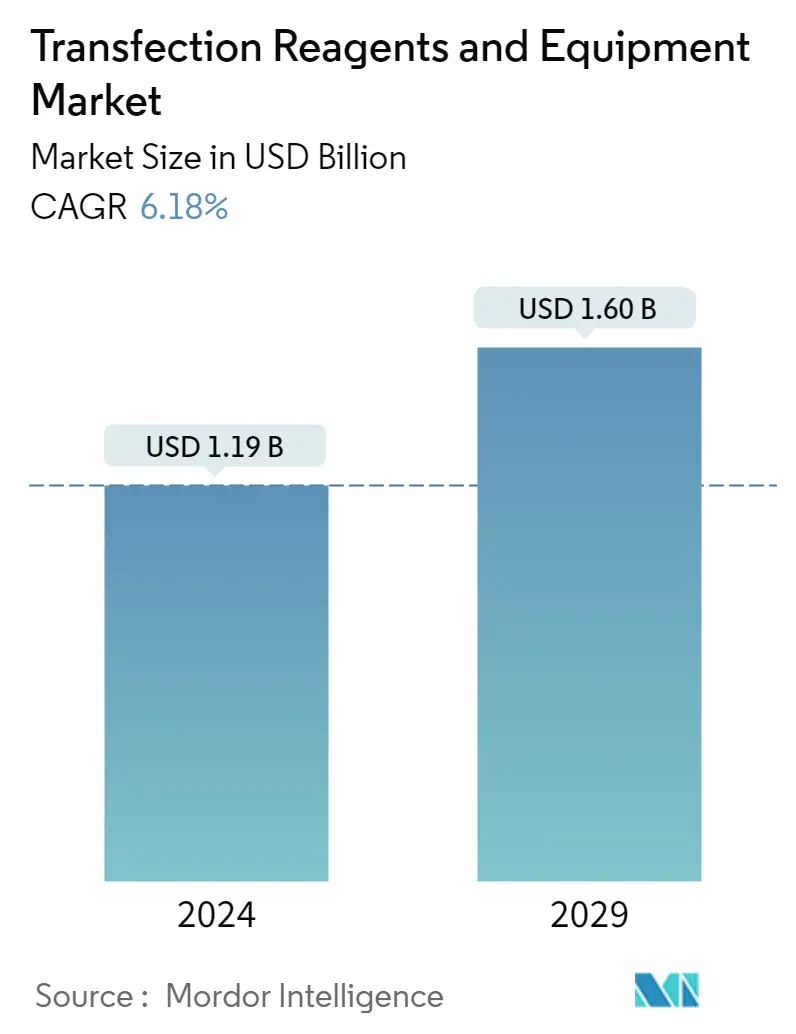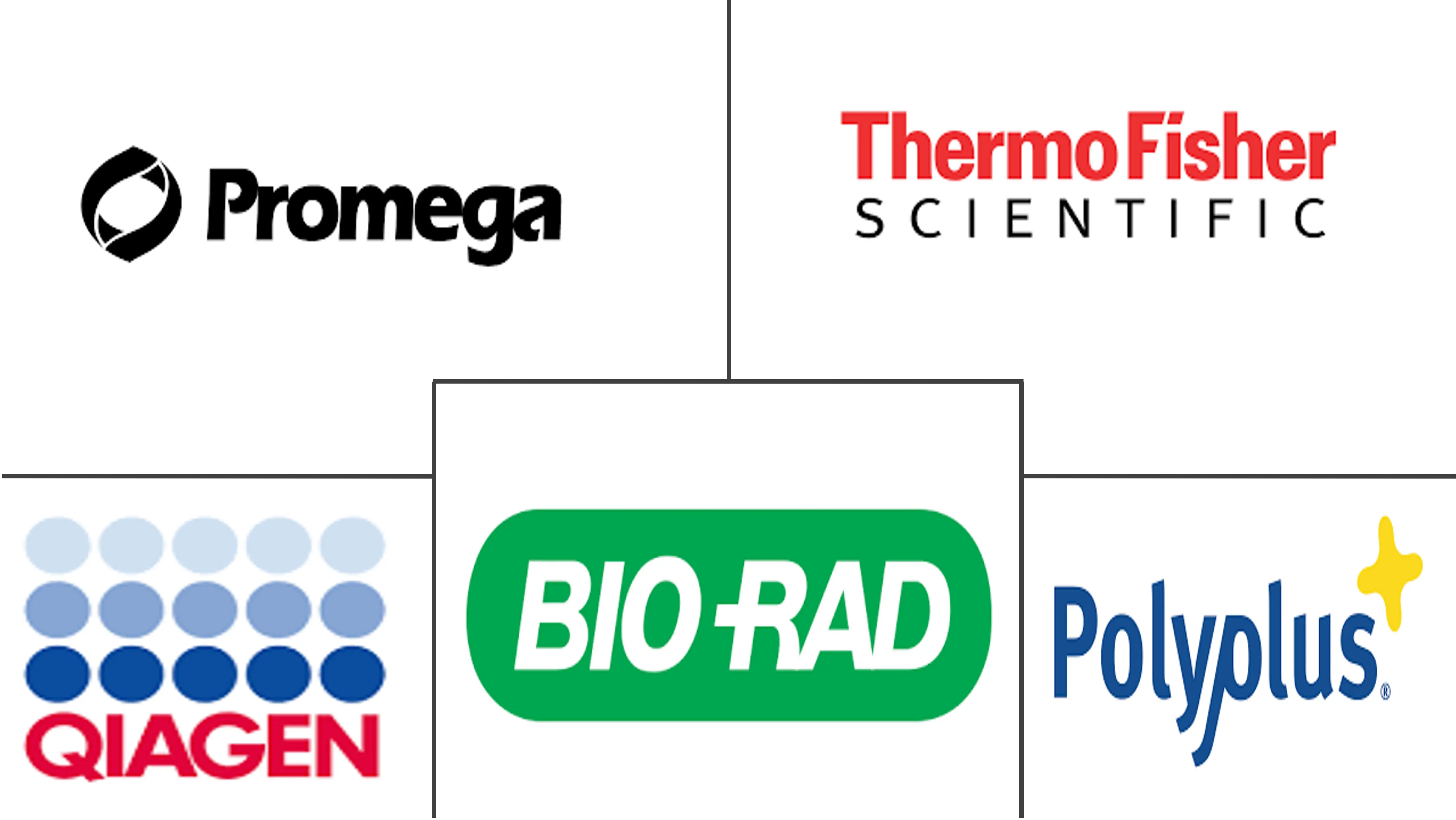Market Size of Transfection Reagents and Equipment Industry

| Study Period | 2019 - 2029 |
| Market Size (2024) | USD 1.19 Billion |
| Market Size (2029) | USD 1.60 Billion |
| CAGR (2024 - 2029) | 6.18 % |
| Fastest Growing Market | Asia-Pacific |
| Largest Market | North America |
Major Players
*Disclaimer: Major Players sorted in no particular order |
Transfection Reagents and Equipment Market Analysis
The Transfection Reagents and Equipment Market size is estimated at USD 1.19 billion in 2024, and is expected to reach USD 1.60 billion by 2029, growing at a CAGR of 6.18% during the forecast period (2024-2029).
Many companies developing COVID-19 vaccines were using viral vectors to ensure effective vaccine delivery. However, the production of viral vectors was a cumbersome and challenging process, and any improvement to that process could result in more vaccines being made available faster. The viral vector-producing cells need to be transfected with multiple plasmids carrying various viral genes and the vaccine. For instance, according to an article published by PubMed in July 2022, a transfection procedure was used for the purification of the SARS-CoV-2 spike (S) protein ectodomain. As the research and development of COVID-19 vaccines gained pace during the initial pandemic, transfection reagents and equipment were increasingly used in the production and research of vaccines. Thus, the pandemic had a significant impact on the market growth, however as the pandemic has subsided currently, the studied market is expected to have stable growth during the forecast period of the study.
The major factors driving the market growth include technological advancements in transfection, increased R&D expenditure and activities by pharmaceutical and biotech companies, and a rise in demand for synthetic genes.
The introduction of transfection technologies has laid the foundation for the genetic dissection of several causative agents of several diseases. The technological advancements in transfection procedures is a major factor driving the market growth. For instance, according to an article published by PubMed Central in October 2022, it has been observed that recently, strategies to improve human mesenchymal stem cells (hMSCs) transfection have been developed by innovating nanocarriers, nucleic acid cargos, and by priming hMSCs chemically and physically for more efficient transfection. Thus, these types of technological advancements in transfection are expected to boost the market growth.
Moreover, the increasing R&D expenditure and research activities by pharmaceutical and biotech companies are also expected to boost market growth. For instance, according to the 2021 annual report of Pfizer Inc., the company invested USD 13,829 million in FY 2021 which increased heavily as compared to USD 9,343 million in the previous year. Similarly, as per a press release published in April 2022 by Biocon Biologics Limited, a subsidiary of biopharmaceutical market player Biocon, the company expects its R&D expenses to increase heavily between 10-15% in the next financial year (FY 2023), as the company is advancing its pipeline to drive future growth. Thus, the rising R&D expenditure of such pharmaceutical and biotechnology companies is expected to boost market growth.
Additionally, the rising developments by various market players are also expected to boost market growth. For instance, in May 2021, Lonza Group AG launched the next generation of its popular Nucleofecto Platform. Nucleofector Technology is an effective non-viral cell transfection method, which can be used even for hard-to-transfect cells, such as primary cells and pluripotent stem cells.
Hence, the aforementioned factors such as the rising technological advancements in transfection, rising R&D expenditure of such pharmaceutical and biotechnology companies, and the increasing developments by various market players are expected to boost the market growth. However, the high cost of transfection reagents and selective effectiveness and certain limitations of transfection reagents can restrain the market growth over the forecast period.
Transfection Reagents and Equipment Industry Segmentation
As per the scope of the report, transfection refers to the process of artificially introducing nucleic acids (DNA or RNA) into eukaryotic cells. Such introductions of foreign nucleic acid using various chemical, biological, or physical methods can result in changing the properties of the cell, allowing the study of gene function and protein expression in the context of the cell. The reagents and equipment used in this procedure are referred to as transfection reagents and equipment. The transfection reagents and equipment market is segmented by product (reagents and equipment), by method (biochemical method, physical methods, and viral methods), by end-user (pharmaceutical and biotechnology companies, and academics and research institutes, and others), and by geography (North America, Europe, Asia-Pacific, Middle East and Africa, and South America). The report also covers the estimated market sizes and trends for 17 different countries across major regions globally. The report offers the value (in USD million) for the above segments.
| By Product | |
| Reagents | |
| Equipment |
| By Method | |
| Biochemical Methods | |
| Physical Methods | |
| Viral Methods |
| By End User | |
| Pharmaceutical & Biotechnology Companies | |
| Academics & Research Institutes | |
| Others |
| Geography | ||||||||
| ||||||||
| ||||||||
| ||||||||
| ||||||||
|
Transfection Reagents and Equipment Market Size Summary
The transfection reagents and equipment market is poised for steady growth, driven by technological advancements and increased research activities in the pharmaceutical and biotechnology sectors. The market's expansion is largely attributed to the rising demand for synthetic genes and the development of innovative transfection technologies, such as nanocarriers and nucleic acid cargos, which enhance the efficiency of transfection procedures. These advancements have facilitated the genetic dissection of various disease-causing agents, thereby supporting the development of new therapeutic strategies. The market's growth trajectory is further bolstered by the substantial investments in research and development by major pharmaceutical companies, which are increasingly focusing on genetic therapies to address complex diseases like cancer and genetic disorders.
In addition to technological progress, the market is experiencing a surge in activity due to collaborations and strategic partnerships aimed at advancing genetic research and product development. Key players in the industry, including Bio-Rad Laboratories, Lonza Group, and Thermo Fisher Scientific, are actively expanding their product offerings and enhancing their technological capabilities to meet the growing demand for transfection solutions. The market's competitive landscape is characterized by the presence of several major companies that hold significant market shares. Despite the promising growth prospects, challenges such as the high cost of transfection reagents and their selective effectiveness may pose constraints. Nonetheless, the increasing funding for genomics research and the ongoing developments by market players are expected to sustain the market's growth momentum in the coming years.
Transfection Reagents and Equipment Market Size - Table of Contents
-
1. MARKET DYNAMICS
-
1.1 Market Overview
-
1.2 Market Drivers
-
1.2.1 Technological Advancements in Transfection
-
1.2.2 Increase in R&D Expenditure and Research Activities by Pharmaceutical and Biotech Companies
-
1.2.3 Rise in Demand for Synthetic Genes
-
-
1.3 Market Restraints
-
1.3.1 High Cost of Transfection Reagents
-
1.3.2 Selective Effectiveness and Certain Limitations of Transfection Reagents
-
-
1.4 Porter's Five Forces Analysis
-
1.4.1 Threat of New Entrants
-
1.4.2 Bargaining Power of Buyers/Consumers
-
1.4.3 Bargaining Power of Suppliers
-
1.4.4 Threat of Substitute Products
-
1.4.5 Intensity of Competitive Rivalry
-
-
-
2. MARKET SEGMENTATION (Market Size by Value - USD Million)
-
2.1 By Product
-
2.1.1 Reagents
-
2.1.2 Equipment
-
-
2.2 By Method
-
2.2.1 Biochemical Methods
-
2.2.2 Physical Methods
-
2.2.3 Viral Methods
-
-
2.3 By End User
-
2.3.1 Pharmaceutical & Biotechnology Companies
-
2.3.2 Academics & Research Institutes
-
2.3.3 Others
-
-
2.4 Geography
-
2.4.1 North America
-
2.4.1.1 United States
-
2.4.1.2 Canada
-
2.4.1.3 Mexico
-
-
2.4.2 Europe
-
2.4.2.1 Germany
-
2.4.2.2 United Kingdom
-
2.4.2.3 France
-
2.4.2.4 Italy
-
2.4.2.5 Spain
-
2.4.2.6 Rest of Europe
-
-
2.4.3 Asia-Pacific
-
2.4.3.1 China
-
2.4.3.2 Japan
-
2.4.3.3 India
-
2.4.3.4 Australia
-
2.4.3.5 South Korea
-
2.4.3.6 Rest of Asia-Pacific
-
-
2.4.4 Middle East and Africa
-
2.4.4.1 GCC
-
2.4.4.2 South Africa
-
2.4.4.3 Rest of Middle East and Africa
-
-
2.4.5 South America
-
2.4.5.1 Brazil
-
2.4.5.2 Argentina
-
2.4.5.3 Rest of South America
-
-
-
Transfection Reagents and Equipment Market Size FAQs
How big is the Transfection Reagents and Equipment Market?
The Transfection Reagents and Equipment Market size is expected to reach USD 1.19 billion in 2024 and grow at a CAGR of 6.18% to reach USD 1.60 billion by 2029.
What is the current Transfection Reagents and Equipment Market size?
In 2024, the Transfection Reagents and Equipment Market size is expected to reach USD 1.19 billion.

